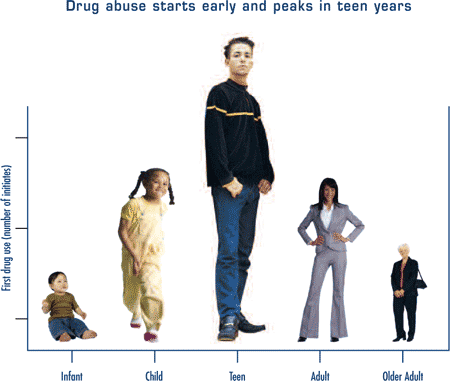Preventing Drug Abuse: The Best Strategy
Why is adolescence a critical time for preventing drug addiction?
As noted previously, early use of drugs increases a person's chances of more serious drug abuse and addiction. Remember, drugs change brains - and this can lead to addiction and other serious problems. So preventing early use of drugs or alcohol may reduce the risk of progressing to later abuse and addiction.
Risk of drug abuse increases greatly during times of transition, such as changing schools, moving, or divorce.12 If we can prevent drug abuse, we can prevent drug addiction. In early adolescence, when children advance from elementary through middle school, they face new and challenging social and academic situations. Often during this period, children are exposed to abusable substances such as cigarettes and alcohol for the first time. When they enter high school, teens may encounter greater availability of drugs, drug abuse by older teens, and social activities where drugs are used.
At the same time, many behaviors that are a normal aspect of their development, such as the desire to do something new or risky, may increase teen tendencies to experiment with drugs. Some teens may give in to the urging of drug-abusing friends to share the experience with them. Others may think that taking drugs (such as steroids) will improve their appearance or their athletic performance or that abusing substances such as alcohol or ecstasy (MDMA) will ease their anxiety in social situations.
Teens' still-developing judgment and decisionmaking skills may limit their ability to assess risks accurately and make sound decisions about using drugs. Drug and alcohol abuse can disrupt brain function in areas critical to motivation, memory, learning, judgment, and behavior control.7 So, it is not surprising that teens who abuse alcohol and other drugs often have family and school problems, poor academic performance, health-related problems (including mental health), and involvement with the juvenile justice system.
Can science-validated programs prevent drug addiction in youth?
Yes. The term "science-validated" means that these programs have been rationally designed based on current knowledge, rigorously tested, and shown to produce positive results. Scientists have developed a broad range of programs that positively alter the balance between risk and protective factors for drug abuse in families, schools, and communities. Research has shown that science-validated programs, such as those described in NIDA's Preventing Drug Use among Children and Adolescents: A Research-Based Guide for Parents, Educators, and Community Leaders, can significantly reduce early use of tobacco, alcohol, and illicit drugs.
How do science-validated prevention programs work?
These prevention programs work to boost protective factors and eliminate or reduce risk factors for drug use. The programs are designed for various ages and can be designed for individual or group settings, such as the school and home. There are three types of programs -
- Universal programs address risk and protective factors common to all children in a given setting, such as a school or community.
- Selective programs target groups of children and teens who have factors that further increase their risk of drug abuse.
- Indicated programs are designed for youth who have already begun abusing drugs.
Are all prevention programs effective in reducing drug abuse?
When science-validated substance abuse prevention programs are properly implemented by schools and communities, alcohol, tobacco, and illicit drug abuse are reduced. Such programs help teachers, parents, and healthcare professionals shape youths' perceptions about the risks of drug abuse. While many events and cultural factors affect drug abuse trends, when youths perceive drug abuse as harmful, they reduce their level of abuse.14
 Source: 2009 Monitoring the Future survey. University of Michigan, with funding from the National Institute on Drug Abuse.
Source: 2009 Monitoring the Future survey. University of Michigan, with funding from the National Institute on Drug Abuse.Good news! Cigarette smoking is at its lowest point since NIDA began tracking it in 1975. But declines in illicit drug use, especially marijuana, have stalled in the past few years. Prevention efforts should be redoubled to counter this troubling trend.
For more information on prevention, see NIDA's most recent edition of Preventing Drug Use among Children and Adolescents: A Research-Based Guide for Parents, Educators, and Community Leaders.



